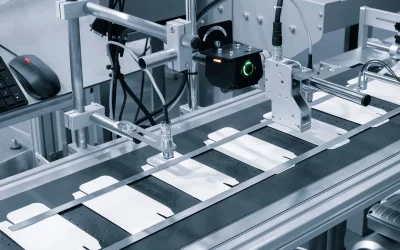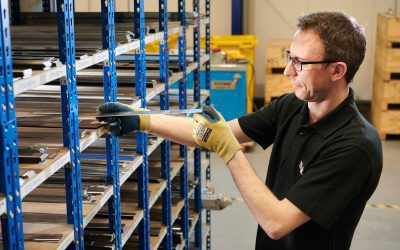1. Healthier food options drive the growth of the food packaging market
The first – and arguably most important trend to be aware of, is that food packaging is becoming increasingly big business. It’s expected that the produce packaging market in particular is set to be worth £34.83 billion by 2027.
This is being driven by consumers choosing to buy healthier food options such as fresh-cut produce.
In response, food packaging designers and manufacturers are investing in new packaging technologies and innovations in food safety. This is resulting in the overall growth of the food packaging market – which is great news for those packaging companies that are forward-thinking and willing to invest in research and development.
2. Sustainable packaging
With environmental concerns increasingly making headlines over recent years, it’s no surprise to find that consumers want their food to be packaged in sustainable materials.
Traditionally, food processors could use PET, PETG, HIPS and other plastics with impunity – but with public awareness of plastic pollution higher than ever – this is no longer possible or desirable.
Instead, expect 2023 to be the year when food packaging manufacturers embrace recycled and sustainably-sourced materials for their packaging.
For example, traditional clamshell and other plastic forms of packaging are being ditched in favour of materials like corrugated cardboard, paperboard trays, and even innovative materials like bioplastic (which are plastics derived from biological sources rather than petroleum).
Whilst making this switch may incur costs, it’s an investment worth making – with consumers saying they’re 70% more likely to spend money with companies that use sustainable packaging materials.
3. Smart packaging technology
New technological developments in recent years have driven a considerable amount of innovation in the packaging space. This has resulted in the rise of ‘smart packaging’.
Expect 2023 to be the year that smart packaging starts to make a big impact.
Smart features such as QR codes, Near-Field Communication (NFC – which allows wireless communication between the packaging and smart devices) and smart labels are set to become increasingly commonplace on food packaging.
Not only can smart packaging technology give consumers more in-depth information about a food product, but logistics professionals can gain data-rich insights, helping them to reduce spoilage and improve supply chain operations.
Smart packaging technology may be cutting edge, but it’ll prove to be a significant competitive advantage for those food packaging manufacturers and processors that embrace it.
4. Customised packaging
It’s no longer good enough to offer the same basic information on your food packaging as every other producer.
Since the COVID-19 pandemic, consumers appear to have changed their food buying habits considerably, opting for healthier choices and becoming more informed on nutrition.
As a result, consumers are expecting more in-depth product information on food packaging. Not only do they want to know the ingredients or composition of the produce, but they also want to know things like its provenance. In other words, consumers are demanding more transparency from food processors.
Aside from this information, consumers also increasingly want to be able to scrutinise foodstuffs, being able to visually analyse them. As a result, a major food packaging trend in 2023 will be packaging types that offer 360 degrees of product visibility.
A knock-on effect from this development is that packaging designs are becoming simpler in order to facilitate this visibility. Think minimalism rather than maximalism when it comes to package branding and design next year.
5. eCommerce-focused packaging
Whilst a significant volume of food purchases continue to take place in brick and mortar stores, a growing number of people are choosing to purchase their groceries online.
This is a trend which has its roots in the COVID-19 lockdowns of 2020 and 2021 – but it has become ingrained. Many consumers continue to shop online.
To give you an idea of the extent of this shift, around 43% of consumers now shop for food online, compared to only 24% two years ago.
Food packaging designers and manufacturers have responded by including features on packaging that link the brick and mortar experience to the online one. These features include things like QR codes, which allow consumers to pay for goods using their smartphone – or to save items to ‘favourites’ when they are shopping in-store, for purchase at a later date online.
6. Storytelling
With significant portions of the food industry becoming commoditized (i.e. there isn’t a huge difference between one similar product and another), storytelling is set to become a major packaging trend in 2023.
This involves conveying a food brand’s story, values, ethos and more – all printed on the packaging. This allows food producers to differentiate themselves from competitors and explain how their food meets the criteria set out by today’s discerning consumers (e.g. transparency, provenance of food stuffs etc).
7. Rising costs
This is a trend that many food processors won’t want to see, but the fact of the matter is that the cost of producing packaging materials is set to rise in 2023.
Various factors including rampant inflation, the war in Ukraine, and significant disruptions in global energy and trade flows means that the raw materials used to produce packaging are going to become more expensive in 2023.
This makes it more important than ever that the packaging operations of food processors are as efficient and lean as possible.
That’s why you should ensure you’re using the very best machine blades in your processing operations. High-quality machine blades will reduce packaging waste, providing consistent, quality cuts, reducing the amount of packaging material that is damaged or wasted.
Get ready for 2023 with packaging blades from MRMK
2023 is set to offer a potent mix of challenges and opportunities for food processors. If you want to rise to these challenges and make 2023 your most profitable year yet, choose MRMK machine blades for your food processing machinery and plant.
As the UK’s number one industrial machine knife manufacturer, we can supply your food processing operations with blades that’ll maximise production uptime, deliver accurate cuts that reduce waste and more.
Explore MRMK’s range of packaging knives now
For more machine blade buying guides, advice and information, read the MRMK News and Insights Hub
How to Optimise the Performance of Your Packaging Blades | Everything You Need to Know About Thermoforming Machine Knives | 3 Things to Consider When Choosing Industrial Blades for Convenience Food Packaging


 +44 (0) 1909 519815
+44 (0) 1909 519815 


